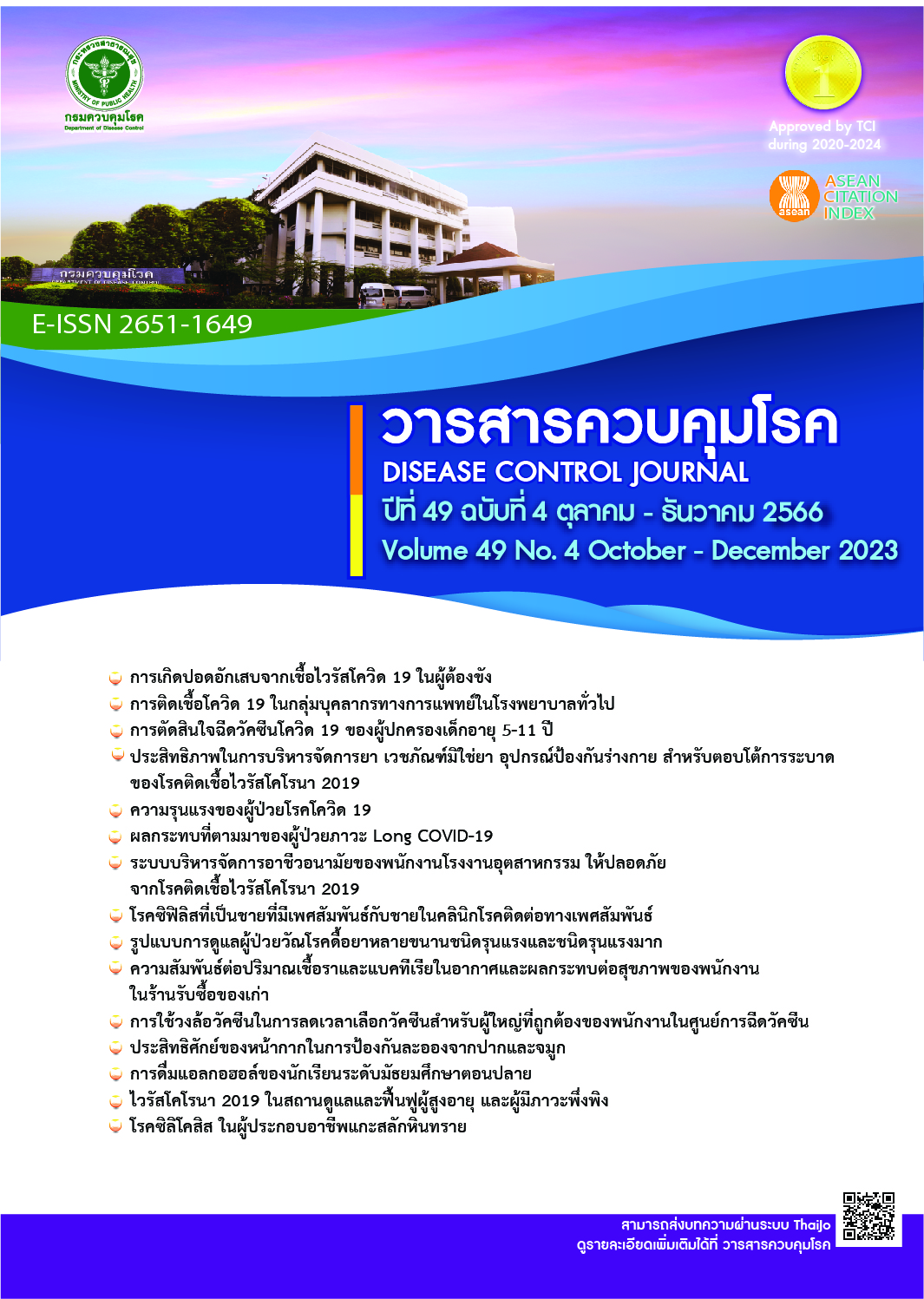Evaluation of mask efficacy to prevent droplets expelled from mouth and nose to environment
DOI:
https://doi.org/10.14456/dcj.2023.67Keywords:
medical mask, fibric mask, dropletsAbstract
The purpose of this study was to compare the efficacy of different types of face masks in preventing droplets (5 types), in 10 volunteers practicing 9 droplet producing activities. The number of droplets dispersed from each volunteer were measured at 1 and 2 meters from the source. The results revealed that the medical mask and 4 types of cloth masks have different droplet reduction potentials at distance of 1 and 2 meters. The average droplet counts in normal breathing as well as in normal speaking was not detected at 1 meter and 2 meters. The activity that had the greatest median droplet count at 1 meter was coughing loudly (90,920 particle/N/M3) and at 2 meters was vigorous breathing (6,601 particle/N/M3). In summary, when wearing masks, all types of masks can reduce droplets at 1 meter and 2 meters but reduction level are differed by different type of mask. Despite wearing a medical mask or a fabric mask of various types, droplets can still be detected at a distance of 1 meter. Therefore, we recommend social distancing should be practiced at the distance of 2 meters and suitable type of masks should be used in places where practice of distancing is limited for effective prevention of diseases.
Downloads
References
Chen N, Zhou M, Dong X, Qu J, Gong J, Han Y, et al. Epidemiological and clinical characteristics of 99 cases of 2019 novel coronavirus pneumonia in Wuhan, China: a descriptive study. ScienceDirect [Internet]. 2020 [cited 2020 Apr 24];395:507-13. Available from: https://
reader.elsevier.com/reader/sd/pii/S0140673620302117?token=5907454E9260605888C330D5DD71287D3DCA7DC1B9DE1297C8D1F72309D720BC0CB4FC81560068EA1BD85F15FFDAD22D
Bhat TA, Goniewicz ML, Thanavala YM. SARS-CoV-2 viral load in upper respiratory specimens of infected patients. N Engl J Med [Internet]. 2020 [cited 2020 Apr 24];382: 1177-9. Available from: https://www.nejm.org/doi/full/10.1056/NEJMc2001737
Department of Disease Control (TH). Corona infectious disease 2019 (COVID-19) [Internet]. [cited 2020 Apr 26]. Available from: https://ddc.moph.go.th/covid19-dashboard/?dashboard=main (in Thai)
Xie X, Li Y, Sun H, Liu L. Exhaled droplets due to talking and coughing [Internet]. 2009 [cited 2020 Apr 24];6:S703-S714. Available from: https://www.ncbi.nlm.nih.gov/pmc/articles/PMC2843952/
Department of Medical Sciences (TH). Department of Medical Sciences showed results of the effectiveness of the cloth mask [Internet]. Nonthaburi: Department of Medical Sciences Ministry of Public Health; 2020. [cited 2020 Apr 26]. Available from: https://www3.dmsc.moph.go.th/post-view/705 (in Thai)
Thai Encyclopedia for Youth By the will of His Majesty the King. Respiratory system [Internet]. [cited 2020 Apr 12]. Available from: http://saranukromthai.or.th/sub/book/book.php?book=8&chap=2&page=t8-2-infodetail20.html (in Thai)
Centers for Disease Control and Prevention. What noises cause hearing loss [Internet]. [cited 2023 Dec 08]. Available from: https://www.cdc.gov/nceh/hearing_loss/what_noises_cause_hearing_loss.html
Ministry of Industry (TH), Thai Industrial Standards Institute. Industrial product standards for single-use hygienic face masks TIS. 2424-2562. Royal Gazette Announcements and general works, Volume No. 137, Episode 22 Ngo. [Internet]. Bangkok: Ministry of Industry; 2019 Feb [cited 2020 Apr 12]. 16 p. Available from: https://bds.sme.go.th/Files/483ae067-8425-46dc-a473-20877b4f99d5.pdf (in Thai)
American Society for Testing and Materials. Standard specification for performance of materials used in medical face masks. [Internet]. c2019; ASTM F2100-19. [cited 2021 Sep 21]. Available from: https://www.astm.org/f2100-21.html
Kumar V, Nallamothu S, Shrivastava S, Jadeja H, Nakod P, Andrade P, et al. On the utility of cloth facemasks for controlling ejecta during respiratory events 2020 [Internet]. 2020 [cited 2021 Jan 12]. Available from: https://arxiv.org/abs/2005.03444
Tang JW, Li Y, Eames I, Chan PKS, Ridgway GL. Factors involved in the aerosol transmission of infection and control of ventilation in healthcare premises. J Hosp Infect [Internet]. 2006 [cited 2021 Jul 13];64(2):100-14. Available from:
https://pubmed.ncbi.nlm.nih.gov/1691 6564/
Brooks JT, Beezhold DH, Noti JD, Coyle JP, Derk RC, Blachere FM, et al. Maximizing fit for cloth and medical procedure masks to improve performance and reduce SARS-CoV-2 transmission and exposure, 2021 [Internet]Morbidity and Mortality Weekly Report (MMWR). 2021;70:254-7. [cited 2021 Aug 1]. Available from: https://www.cdc.gov/mmwr/volumes/70/wr/mm7007e1.htm
Downloads
Published
How to Cite
Issue
Section
License
Copyright (c) 2023 Disease Control Journal

This work is licensed under a Creative Commons Attribution-NonCommercial-NoDerivatives 4.0 International License.
Articles published in the Disease Control Journal are considered as academic work, research or analysis of the personal opinion of the authors, not the opinion of the Thailand Department of Disease Control or editorial team. The authors must be responsible for their articles.






